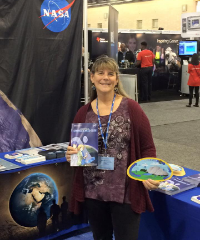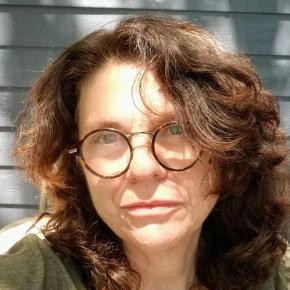Community Blogs
Community Blogs
Discover how the GLOBE community is engaging in all things GLOBE through the community blog posts below.
Learn how to create a GLOBE community blog post.
Filter By:
Blogs List
When you start writing your GLOBE report for IVSS, it might be difficult because you might not sure where to start. We tend to start writing the Methods section first because it is something you did it yourselves and it should be relatively easy and straight forward to write. Second, you should write the Results section, do graphs, tables and texts (think of a best way to present your cool data to the whole world). Third, you should start writing the Introduction stating your hypotheses and predictions. The next step would be the Discussion section. It is funny to say but as scientists, ...
Read More »
Posted in:
Curriculum:
STEM
EDUCATION RESEARCH
SCIENCE AND MATH
TECHNOLOGY
Event Topics:
MEETINGS
SCIENCE SYMPOSIA AND FAIRS
GLOBE Science Topics:
SCIENTIST SKILLS
MEETINGS/CONFERENCES
GLOBE Working Groups:
SCIENCE WORKING GROUP
EDUCATION WORKING GROUP
News Topics:
VIRTUAL SCIENCE FAIR
Primary Audience:
TEACHERS
STUDENTS
Teacher's Guide:
GRADE LEVELS
SECONDARY: 9-12
MIDDLE: 6-8
Currently, Science education has transitioned away from textbooks to more hands on learning. This is an amazing opportunity for teachers to move away from the normal lecturing and explaining in class to reshaping the process of learning.
I think that the GLOBE Program is a fantastic organization and empowered program that promises to give an essential change in education. One example is teaching and learning from directs activities in the field.
An excellent activity is to share data from school to school through collaboration. Students can share what they are ...
Posted in:
Curriculum:
STEM
Event Topics:
OTHER
SCIENCE SYMPOSIA AND FAIRS
GLOBE Science Topics:
EARTH AS A SYSTEM
EARTH SYSTEM SCIENCE
GLOBE PROTOCOLS
GLOBE Working Groups:
EDUCATION WORKING GROUP
Investigation Areas:
ATMOSPHERE
EARTH AS A SYSTEM
HYDROSPHERE
PEDOSPHERE (SOIL)
BIOSPHERE
News Topics:
VIRTUAL SCIENCE FAIR
Primary Audience:
TRAINERS
TEACHERS
STUDENTS
PARTNERS
ALUMNI
COUNTRY COORDINATORS
Many of us are so used to having clean freshwater that is easily accessible that we don't often stop to marvel at the fact that we are incredibly fortunate. The majority of our freshwater comes from our water cycle, and precipitation is unevenly distributed across the globe. You can learn more about the importance of clean freshwater resources in this "one-pager" entitled " Precious Freshness ".
During our ENSO Phase III Webinar #3, we will be focusing on water quality in Europe and Eurasia. We will host this webinar at 18:30 UCT, and hope we will have many of you from ...
Posted in:
Curriculum:
SCIENCE AND MATH
LANGUAGE CULTURE AND ARTS
STEM
Event Topics:
CAMPAIGNS AND PROJECTS (IOPS, ETC)
SCIENCE SYMPOSIA AND FAIRS
Field Campaigns:
WATERSHEDS
EL NIÑO
GLOBE Science Topics:
GENERAL SCIENCE
EARTH AS A SYSTEM
SCIENTIST SKILLS
GLOBE PROTOCOLS
GLOBE Working Groups:
EDUCATION WORKING GROUP
SCIENCE WORKING GROUP
Investigation Areas:
HYDROSPHERE
Learning Activities:
ATMOSPHERE AND CLIMATE
HYDROLOGY
News Topics:
VIRTUAL SCIENCE FAIR
SCRC RESEARCH
Primary Audience:
PARTNERS
SCIENTISTS
ALUMNI
COUNTRY COORDINATORS
TRAINERS
TEACHERS
STUDENTS
What are the impacts of extreme events, like Hurricane Harvey, on the water quality? This article from the Smithsonian magazine describes multiple ways in which public health officials are responding to several threats facing residents of Houston and surrounding locations. These threats include the impact of mold, the potential of an increase in vector-borne diseases such as Zika and West Nile virus, and the problems of contaminants left behind in the public water supply.
Have you experienced severe flooding in your region that resulted in problems with water quality? ...
Posted in:
Curriculum:
STEM
SCIENCE AND MATH
Event Topics:
CAMPAIGNS AND PROJECTS (IOPS, ETC)
SCIENCE SYMPOSIA AND FAIRS
Field Campaigns:
EL NIÑO
WATERSHEDS
GLOBE Science Topics:
EARTH AS A SYSTEM
CLIMATE CHANGE
BACKYARD SCIENCE
CLIMATE
Investigation Areas:
ATMOSPHERE
EARTH AS A SYSTEM
HYDROSPHERE
PEDOSPHERE (SOIL)
BIOSPHERE
News Topics:
SCRC RESEARCH
One way to teach students about water quality and/or how scientists go about their work is to share articles with them. Here is a great article entitled " Study Maps Hidden Water Pollution in U.S. Coastal Areas ". This research shows a great example of the use of both NASA satellite data and ground-based data. In this study, the researchers used U.S. topographic data as well as NASA climate models to "identify key inland regions that contribute groundwater and contaminants to the coast. They examined rainfall, evaporation rates and the amount of known surface runoff to ...
Posted in:
Curriculum:
STEM
SCIENCE AND MATH
Event Topics:
CAMPAIGNS AND PROJECTS (IOPS, ETC)
SCIENCE SYMPOSIA AND FAIRS
Field Campaigns:
EL NIÑO
GLOBE Science Topics:
EARTH AS A SYSTEM
EARTH SYSTEM SCIENCE
SCIENTIST SKILLS
CLIMATE CHANGE
DATA INCLUDED
CLIMATE
Investigation Areas:
EARTH AS A SYSTEM
HYDROSPHERE
Learning Activities:
EARTH AS A SYSTEM
ATMOSPHERE AND CLIMATE
HYDROLOGY
It is pretty neat when you can get two for the price of one- as most teachers can attest to with regard to trying to get everything into their curriculum. Did you know that this year, the FIRST LEGO League's challenge is focused on water. And what could be better, as that water is also the theme of this year's ENSO Student Research Campaign !
The LEGO Challenge Project states: "People use water every day, but they don’t think much about how and why they use water. Whether it’s directly (drinking or washing) or indirectly (manufacturing the products they use or producing food ...
Posted in:
Curriculum:
STEM
SCIENCE AND MATH
Event Topics:
CAMPAIGNS AND PROJECTS (IOPS, ETC)
SCIENCE SYMPOSIA AND FAIRS
COMPETITIONS
Field Campaigns:
EL NIÑO
WATERSHEDS
GPM
GLOBE Science Topics:
EARTH AS A SYSTEM
EARTH SYSTEM SCIENCE
GLOBE PROTOCOLS
CLIMATE CHANGE
CLIMATE
Investigation Areas:
ATMOSPHERE
Learning Activities:
EARTH AS A SYSTEM
ATMOSPHERE AND CLIMATE
News Topics:
COMPETITIONS
Primary Audience:
TEACHERS
STUDENTS
From the start, the measurement of daily maximum and minimum air temperature within one hour of local solar noon has been a key GLOBE protocol. The low cost approach was to use a U-tube thermometer housed in a wooden instrument shelter facing away from the equator. The U-shaped tube contained mercury with pins on either side of the mercury. As the air temperature warmed the pin on one side would move while the other pin stayed in place; when the air cooled, the pin on the other side would be pushed up. The pins were held in place by magnetized strips behind the thermometer tube so that ...
Posted in:
Curriculum:
STEM
TECHNOLOGY
GLOBE Science Topics:
EARTH AS A SYSTEM
EARTH SYSTEM SCIENCE
GLOBE PROTOCOLS
CLIMATE CHANGE
CLIMATE
GLOBE Working Groups:
SCIENCE WORKING GROUP
Investigation Areas:
ATMOSPHERE
Primary Audience:
TEACHERS
TRAINERS
STUDENTS
PARTNERS
SCIENTISTS
ALUMNI
COUNTRY COORDINATORS
https://docs.google.com/forms/d/e/1FAIpQLSc3kwd0hHXG--39z2ADxi7-blg11wAx1RUG42GVHgsG12BP6g/viewform?c=0&w=1 Did you know that mosquito-borne diseases are impacted by both the El Nino and the La Nina weather patterns? Tonight during the ENSO Student Research Campaign Webinar #10 (at 8 pm EST) Dr. Assaf Anyamba will share the results of his research on the impact of these different patterns on the onset of Rift Valley fever in parts of Africa. As we know, these changing weather patterns alter the normal climatic conditions for regions around the world. In some places, this results in ...
Posted in:
Curriculum:
STEM
EDUCATION RESEARCH
SCIENCE AND MATH
TECHNOLOGY
Event Topics:
CAMPAIGNS AND PROJECTS (IOPS, ETC)
Field Campaigns:
EL NIÑO
GLOBE Science Topics:
EARTH SYSTEM SCIENCE
SCIENTIST SKILLS
CLIMATE CHANGE
CLIMATE
Investigation Areas:
ATMOSPHERE
EARTH AS A SYSTEM
HYDROSPHERE
PEDOSPHERE (SOIL)
BIOSPHERE
Learning Activities:
EARTH AS A SYSTEM
Primary Audience:
TRAINERS
TEACHERS
SCIENTISTS
GLOBE is a useful resource for educators in both the formal and informal sector. Below is a guest blog post from GLOBE trained educator Jane Amiotte who is the 4H Youth Program Advisor in Pennington County here in South Dakota. One of the things that I think Jane does well is to use GLOBE with other resources and in various settings. GLOBE mixes and matches well!
How do you use GLOBE in your setting?
~~~~~~~~~~~~~~~~~~~~~~~~~~~~~~~~~~~~~~~~~~~~~~~~~~~~~~
Earth Systems
I presented the Elementary GLOBE Earth Science Systems program “We Are All Connected” to the classrooms ...
Posted in:
Curriculum:
STEM
Investigation Areas:
SOIL CHARACTERIZATION
EARTH AS A SYSTEM
FRESHWATER MACROINVERTEBRATES
BIOMETRY (INCLUDING TREE HEIGHT)
AEROSOLS
Primary Audience:
TRAINERS
TEACHERS
Teacher's Guide:
UPPER PRIMARY: 3-5
LOWER PRIMARY: K-2
Scientists rely on research, statistical models, and climate forecast models to help them determine upcoming natural events.
Currently, scientists are have a difficult time deciding if and when the potential big El Niño event will happen. It will happen in 2017, but will it be the Summer or Fall?
"Right now, many climate forecast models do predict the development of a full-fledged El Niño during this summer or fall. It’s likely that these models are acting on the much warmer-than-average waters near the coast of South America—the “Coastal El Niño" says Anthony Barson in his NOAA ...
Posted in:
Curriculum:
STEM
ASSESSMENT AND EVALUATION
EDUCATION RESEARCH
LANGUAGE CULTURE AND ARTS
SCIENCE AND MATH
TECHNOLOGY
Field Campaigns:
EL NIÑO
SMAP
Investigation Areas:
ATMOSPHERE
EARTH AS A SYSTEM
HYDROSPHERE
PEDOSPHERE (SOIL)
BIOSPHERE
Learning Activities:
EARTH AS A SYSTEM
ATMOSPHERE AND CLIMATE
LAND COVER/BIOLOGY
HYDROLOGY
SOIL
Primary Audience:
PARTNERS
SCIENTISTS
ALUMNI
COUNTRY COORDINATORS
TRAINERS
TEACHERS
STUDENTS
Just when you think that perhaps the weather systems are settling down- our amazing scientific instruments are able to detect a potential change! I never cease to be amazed at what we are able to learn about Earth's systems- both from the ground and from space!
This article from the New York Times just came across my newsfeed- " It's Like it Never Left: Another El Nino May be on the Way ".
In the article, it states that " Among the potential effects are wetter conditions across the southern United States, including Southern California; a drier Midwest; and drought in ...
Posted in:
Curriculum:
STEM
EDUCATION RESEARCH
SCIENCE AND MATH
Event Topics:
CAMPAIGNS AND PROJECTS (IOPS, ETC)
Field Campaigns:
EL NIÑO
GLOBE Science Topics:
EARTH SYSTEM SCIENCE
CLIMATE CHANGE
BACKYARD SCIENCE
CLIMATE
EARTH AS A SYSTEM
SCIENTIST SKILLS
GLOBE PROTOCOLS
GLOBE Working Groups:
EDUCATION WORKING GROUP
Investigation Areas:
ATMOSPHERE
EARTH AS A SYSTEM
HYDROSPHERE
PEDOSPHERE (SOIL)
BIOSPHERE
News Topics:
VIRTUAL SCIENCE FAIR
Primary Audience:
PARTNERS
SCIENTISTS
ALUMNI
COUNTRY COORDINATORS
TRAINERS
TEACHERS
STUDENTS
How do you ENSO?
Did you know that students from around the world are taking measurements as part of the NASA GLOBE ENSO Student Research Campaign?
Check out what's happening at the Medford Memorial Middle School in New Jersey, USA!
We are looking for YOUR videos, showcasing your students taking measurements that are part of the NASA GLOBE ENSO Student Research Campaign. (Note, you will need to have GLOBE photo releases for each of the students shown in your video. They can be found HERE .
Please contact Brian Campbell for more details and/or ...
Posted in:
Curriculum:
STEM
Field Campaigns:
EL NIÑO
SMAP
Investigation Areas:
ATMOSPHERE
EARTH AS A SYSTEM
HYDROSPHERE
PEDOSPHERE (SOIL)
BIOSPHERE
Primary Audience:
TRAINERS
TEACHERS
STUDENTS
PARTNERS
SCIENTISTS
ALUMNI
COUNTRY COORDINATORS
Consider the rain gauge used in GLOBE, CoCoRaHS, and other citizen science programs. Just four pieces plus 2 mounting screws – an inner graduated cylinder, an outer cylinder, a cap/funnel, and a mounting bracket. The area of the outer tube is exactly 10 times the areas of the inner tube and the cap/funnel, so the graduations on the inner cylinder can be spaced ten times further apart. Thus, 0.2 mm of rain fills the inner tube to a depth of 2.0 mm, which one can read.
In addition, if heavy rainfall fills the inner cylinder, the rest of the rainfall overflows into the outer cylinder, ...
Posted in:
Curriculum:
STEM
Field Campaigns:
EL NIÑO
GPM
GLOBE Science Topics:
BACKYARD SCIENCE
GLOBE PROTOCOLS
Investigation Areas:
ATMOSPHERE
Primary Audience:
TEACHERS
STUDENTS
ALUMNI
—
20 Items per Page











